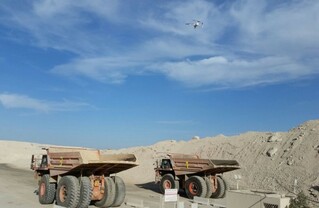Of all the industries poised to be revolutionised by the adoption of industrial drones, it is perhaps mining that has the most to gain. After all, drones could potentially play a role in almost every stage of a surface mine’s operations, bringing precision and consistency to an industry so often ruled by ever-shifting variables.
In mining – and in virtually every other industry – the key to widespread industrial drone adoption will be those drones living up to their potential, specifically their ability to actually make operations and business processes safer, faster and cheaper. For some drones this has been a considerable hurdle to overcome, but there is an innovation that is enabling industrial drones to live up to their lofty potential in mining: automation.
Not all drones
On the surface it would seem industrial drones should be able to unquestionably make operations safer, faster and cheaper. After all, they can take care of many of the dangerous, dirty and tedious jobs employees would otherwise have to put themselves at risk to complete, they are able to travel more quickly than people and can more easily access remote locations and tighter spaces and collect an unlimited amount of data. And not only does a drone cut down on expensive manpower hours required for many mining operations, they can also replace more expensive equipment such as CCTV surveillance systems.
However, there is one major issue with many industrial drones, and it’s admittedly a surprising one: drone pilots. To be clear, drone pilots are carefully trained, highly certified, and generally very skilled at operating drones. They’re also very expensive, regardless of if an employee is put through the certification process, or if a contractor is hired and works on-call. Requiring a drone pilot for flight also makes on-demand flights much tougher, introducing significant delays. Emergency response flights are all but impossible. Lastly, skilled though they may be, having a human operator flying a drone and collecting data introduces the potential for human error.
When all these factors are taken into consideration, mining companies may find that it’s faster to send an employee to check equipment at a blast site or send a surveyor to a haul road than to wait for a drone pilot. It could certainly be cheaper as well. If drones aren’t faster and cheaper, then it’s going to be employees still being sent out to complete these dangerous jobs. That leaves safer, faster and cheaper all unchecked.
Automatically superior

The optimal drone for mining, as well as most other industries, is turning out to be the automated drone. Automated drones can operate with minimal human intervention, even no human intervention in many cases. They can automatically deploy, fly both preplanned and on-demand missions, land, collect endless amounts of data, transmit that data, and process it. Leading automated drones also handle their own routine maintenance including the changing of batteries so they’re always ready to fly, and payload and sensor changing to allow a drone to complete a wide range of tasks.
This eliminates the expense, delays and potential for human error associated with drone pilots, and the downtime associated with drone maintenance, which makes automated drones an improvement upon many traditional mining operation methods, including a significant number that put employees at risk. There you have it: faster, cheaper, safer.
Mine over matter
The applications of an automated drone in mining range from blasting preparations to safety checks to keeping critical infrastructure in optimal condition. Specifically, potential automated drone uses in mining include:
Surveying and mapping - Instead of sending employees out to take measurements over huge distances on difficult terrain, an automated drone can complete surveying and mapping missions in hours that would have taken those at-risk human surveyors days, all with a marked increase in accuracy.
Haul road inspection - Keeping haul roads in the best possible condition keeps traffic flowing, cuts down on truck and equipment repair, and protects drivers and other personnel. Automated drones can complete regular inspections with the high level of precision required to spot issues as they begin to emerge, and can quickly respond to incidents or provide imagery and other information to engineers on problems like brand new potholes that require repairs.
Equipment and infrastructure inspection - It’s never been faster or easier to inspect equipment and infrastructure for issues and any potential maintenance needs than it is with an automated drone. These inspections can be accomplished with high-resolution photos, video, 3-D modelling or infrared scans.
Tailings dam management - With the immense amount of aerial data that automated drones are able to easily transmit, they can identify significant tailings dam issues like erosion or surface cracking, identify other issues requiring maintenance, and help mining engineers actively monitor dam strength. With the major liability a sub-optimal tailings dam represents, these important steps for preventing dam failure are beyond essential.
Drilling and blasting optimisation - To aid in the drilling and blasting processes, automated drones can provide digital elevation models both before and after blasts, help match drill-hole alignment to the blast plan, capture footage of the blast for analysis, and provide fragmentation analysis that helps inform downstream comminution processes.
Stockpile evaluation and management - Automated drones can help mining professionals efficiently and manage stockpiles by allowing for frequent and accurate measurements, tracking ore grade quantities mixed to calculate blended piles, and minimising misclassification by archiving ore grades and profiling historical stockpile grades throughout the lifespan of a stockpile.
Flying high
In mining as in so many other industries, there just isn’t room to care about potential. It’s the actual that matters, and right now, it’s automated drones that are able to improve mining operations by cutting costs, increasing efficiencies and protecting employees. It may be easy to see the potential of standard industrial drones, but when it comes to truly delivering on that potential, it has to be automated.
























